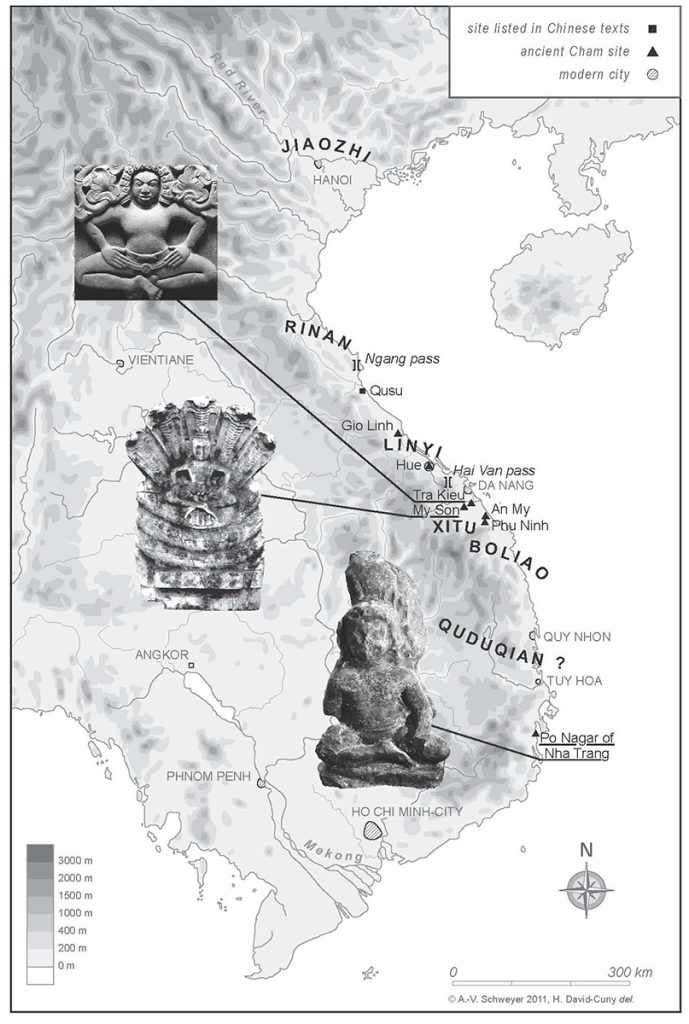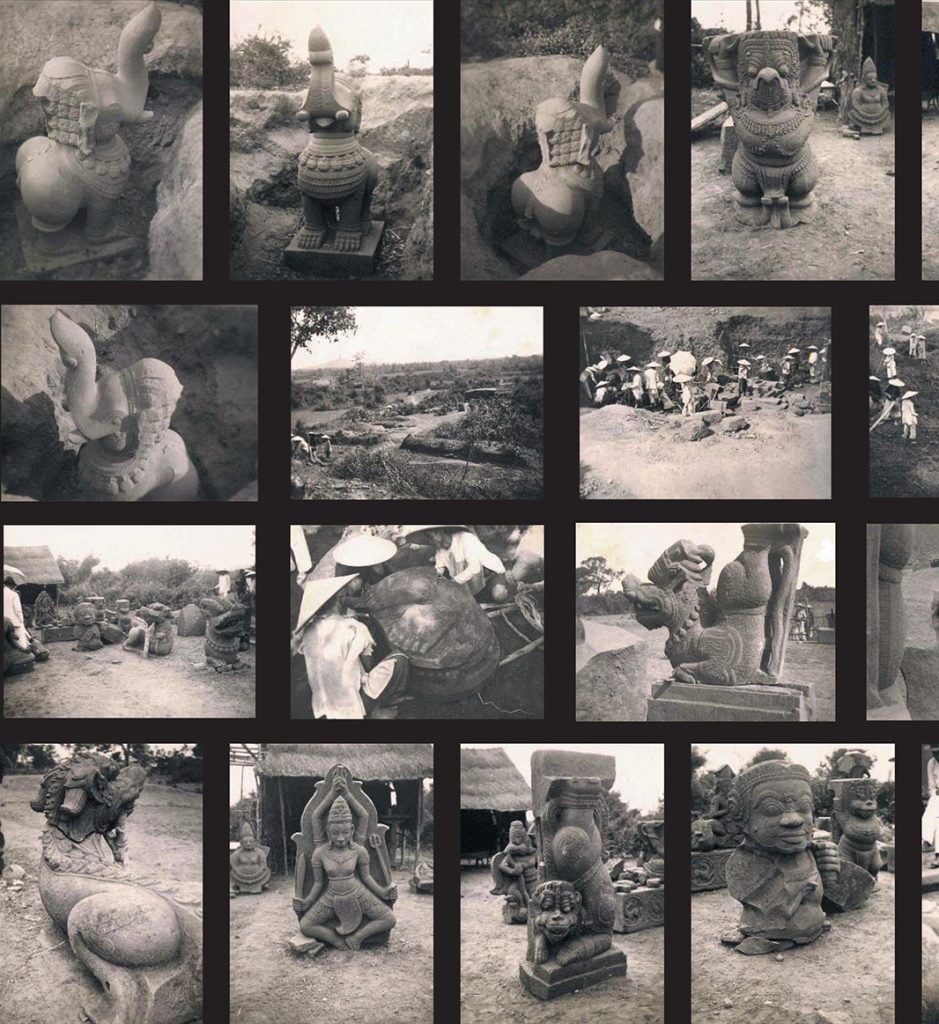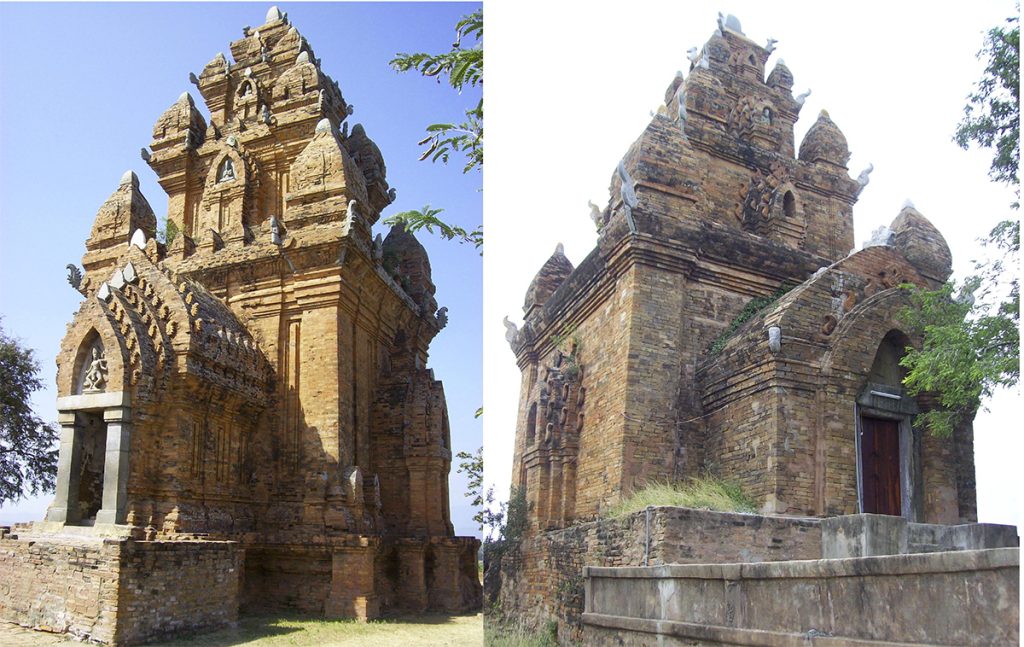
ប្រភព៖ Schweyer
ប្រវត្តិសាស្រ្តនៃរដ្ឋចម៉្បា គឺប្រហែលជាកើតឡើងនៅសតវត្សន៌ទី៣នៃគ.ស. នៅពេលដែលលេចឡើងនូវឈ្មោះ លីន យី (Linyi) ក្នុងឯកសារចិនដែលមានន័យថា ទីក្រុងនៃលីន “city of the Lin” ដោយសំដៅលើតំបន់នយោបាយឯករាជ្យមួយស្ថិតនៅតាមសមុទ្រចិនខាងត្បូង ។ បច្ចុប្បន្នសិ្ថតនៅតំបន់ភាគកណ្តាលនៃប្រទេសវៀតណាម។ ចំពោះពាក្យ លីន យី ឃើញមានការកត់ត្រាក្នុងឯកសារចិន នៅស.វ.ទី៣ និងនៅអំឡុងឆ្នាំ ៦៥៨គ.ស. លេចឡើងនូវឈ្មោះ ចម្ប៉ា Campā ឬ ចាម Cham នៅក្នុងសិលាចារឹក C.96 ក្នុងតំបន់ក្រុមប្រាសាទ Mỹ Sơn។ បន្ទាប់មកទៀត នៅឆ្នាំ៦៦៧ ក្នុងសិលាចារឹកខ្មែរនៅក្តីអង្គ ក្នុងខេត្ត ព្រៃវែង ក៏ឃើញមានការលើកឡើងពីឈ្មោះ ចាម ដែរ។
គួរបញ្ជាក់ដែរថា រដ្ឋដំបូងៗក្នុងតំបន់អាស៊ីអាគ្នេយ៌ គឺសុទ្ធតែទទួលឥទិ្ធពលពីឥណ្ឌា ( Indianization) ទាំងផ្នែកសាសនា (ហិណ្ឌូ) នយោបាយ អក្សរ(សំស្ក្រឹត) និងសិល្បៈផ្សេងៗ ព្រមទាំងមានទំនាក់ទំនងជាមួយនឹងចិន (Sinicization) ផ្នែកពាណិជ្ជកម្មផ្លូវសមុទ្រជាដើម ក្នុងនោះរួមមាន ហ្វូណន ទ្វារវត្តី ជ្វា និង ចម៉្បានេះជាដើម។ នៅឆ្នាំ ៧៤៩ ស្តេចរុទ្រវរ្ម័នបានបញ្ជូនសួយសាអាករទៅស្តេចចិន ប៉ុន្តែពុំឃើញមានកត់ត្រានូវឈ្មោះ លីន យី ទៀតនោះទេ ដែលជំនួសមកវិញនៅស្តេចនៃចាម។ ក្រោយពីឆ្នាំ៨៥៩គ.ស. នៅក្នុងឯកសារចិន បានកត់ត្រា ពាក្យ Zhan Cheng ដែលមានន័យថាទីក្រុងនៃចាមដែលជាភាសាសំស្រ្តឹត Campānagara ឬ Campāpura ដែលឃើញមាននៅក្នុងសិលាចារឹក។

ប្រភព៖ Schweyer
សិលាចារឹកដំបូងដែលចារជាភាសាសំស្រឹ្កត បានលេចឡើងនៅក្នុងរាជ្យព្រះបាទភវរ្ម័នដែលបង្ហាញពីភស្ថុតាងនៃការជ្រួតជ្រាបនៃសាសនាហិណ្ឌូ ក្នុងសង្គមចម្ប៉ា។ ការបង្ហាញនោះ គឺតាមរយៈការសសើរទេពសំខាន់ៗក្នុងសាសនាហិណ្ឌូ រួមមាន ព្រះព្រហ្ម ព្រះវិស្ណុ និងព្រះឥសូរ ក្នុងទម្រង់ជាលិង្គ។ ប្រហែលនៅឆ្នាំ៨៧៥ មានរាជ្យវង្សថ្មីមួយដែលមានឈ្មោះថា ឥន្រ្ទបុរ (Indrapura) និងមានទីក្រុងស្ថិតនៅតំបន់កណ្តាលនៃអាណាម (Center Annam) ក្បែរនឹង Dong Duong។ នៅទីនោះ អ្នកស្រាវជ្រាវបានរកឃើញព្រះពុទ្ធរូបអំពីសំរឹទ្ធដែលមានទម្រង់ដូចនឹងព្រះពុទ្ធនៅស្រីលង្កា ក្នុងស.វ.ទី២ ឬ ទី៣នៃគ.ស.។ តាមរយៈលោក Pierre Dupont បានលើកឡើងថារាជ្យវង្សឥន្រ្ទបុរគឺគោរពព្រះពុទ្ឋសាសនាថេរវាទដូចទៅនឹងស្រីលង្កា។

ប្រភព៖ Schweyer
ទីក្រុងសំខាន់ៗនៃរដ្ឋចម្ប៉ារួមមាន Amaravati (Quang Nam), Vijaya (Binh Dinh), Kauthara (Nha Trang), Panduranga (Phan Rang) ដែលសុទ្ធសឹងជាទីក្រុងនៃបណ្តុំសំណង់ ប្រាសាទហិណ្ឌូ។ ក្រុមប្រាសាទ My son ដែលស្ថិតនៅក្នុងទីក្រុង Amaravati បច្ចុប្បន្នស្ថិតក្នុងខេត្ត Quang Nam គឺជាបណ្តុំប្រាសាទដ៏សំខាន់មួយនៅក្នុងសិល្បៈចម្ប៉ា។

ប្រភព៖ Schweyer

ប្រភព៖ Schweyer
យើងក៏ឃើញមានទំនាក់ទំនងរវាងខ្មែរ និងចម្ប៉ាដែរ ដោយចាប់ពីចុងស.វ.ទី១០ និងចាប់ពីក្នុងរាជ្យរបស់ព្រះបាទឧទិយទិត្យវរ្ម័នទី២ ក្នុងស.វ.ទី១១ រហូតដល់ក្នុងរាជ្យរបស់ព្រះបាទជ័យវរ្ម័នទី៧ ក្នុងស.វ.ទី១២។ ទំនាក់ទំនងនេះតាមរយៈការធ្វើសង្រ្គាមរវាងខ្មែរ និងចាម ដែលឃើញមានចម្លាក់នៅតាមប្រាសាទបាយ័ន្ត និងសិលាចារឹក។
សរុបមកនៅចុងស.វ.ទី១៥ ចម្ប៉ា ឬចាមចាប់ផ្តើមបាត់បង់ទឹកដីស្ទើរតែទាំងស្រុងដោយសារការឈ្លានពានពីដៃវៀត (Đại Việt) និង នៅសល់ត្រឹមតែទីក្រុង Panduranga ដែលជាទីក្រុងចុងក្រោយរបស់ចាម រហូតដល់ស.វ.ទី១៧ ចាមត្រូវបានបាត់បង់ទឹកដីទាំងស្រុង៕
——————————
Champa Culture
The history of the Champa state was probably established in the third century when the name Linyi appeared in Chinese documents, it means “city of the Lin”, referring to an independent political area in the South China Sea. Presently, this location is in central Vietnam. The word Linyi was recorded in Chinese documents in the 3rd century during the year 658 AD. The name Campā or Cham appears in inscription C.96 in the area of the Mỹ Sơn temple complex. Later, in the year 667, in the Khmer inscription at Kday Ang, Prey Veng province, also was mentioned the name Cham.
Remarkably that the first states in Southeast Asia were all influenced by India (Indianization) in terms of religion (Hindu), politics, script (Sanskrit), and other arts, as well as had a business relationship with China (Sinicization) through marine trade, including Funan, Dvaravati, Java, and Champa. In 749, King Rudravarman sent a tribute to the Chinese king, but the name Lin Yi was no longer recorded, replacing it with the king of Cham. After 859 AD in Chinese documents, the word Zhan Cheng, which means the city of Cham and in the Sanskrit language is Campānagara or Campāpura, is found in the inscriptions.
The first Sanskrit inscriptions appeared during the reign of Bhavarman, showing evidence of the infiltration of Hinduism into Champa society. That manifestation is through the worship of the major gods in Hinduism, including Brahma, Vishnu, and Siva in the form of Linga. Around 875 AD, there was a new capital city of Champa called Indrapura and a city in the Center Annam near Dong Duong dynasty where researchers found a bronze Buddha image in the form likely a Buddha in Sri Lanka in the 2nd or 3rd century. According to Pierre Dupont stated that the Indrapura site respected Theravada Buddhism as much as Sri Lanka.
The main cities of Champa include Amaravati (Quang Nam), Vijaya (Binh Dinh), Kauthara (Nha Trang), Panduranga (Phan Rang), which are all cities of Hindu temple complexes. My Son Temple complex, located in Amaravati, now in Quang Nam Province, is one of the most important temples in Champa art.
We also see the relationship between Khmer and Champa, from the end of 10th century and from the reign of King Udayadityavarman II in 11th century until the reign of King Jayavarman VII in the 12th century. This relationship is made through the war between Khmer and Cham, which is found in the sculptures at the Bayon temple and the inscriptions.
In conclusion, by the end of the 15th century, Champa or Cham began to lose almost all of its territory due to the invasion of the Đại Việt, and only Panduranga was left which is the last city of Cham then until the 17th century Cham was completely lost territory.
អត្ថបទដើម៖ លោក អេង តុលា






